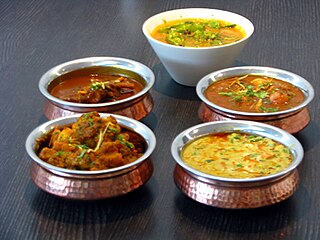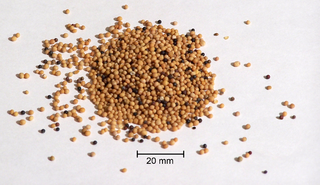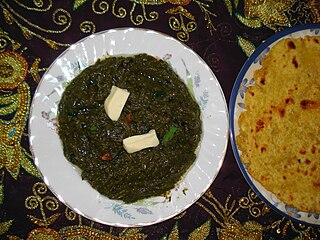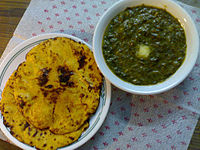
Curry is a variety of dishes originating in the Indian subcontinent that use a complex combination of spices or herbs, usually including ground turmeric, cumin, coriander, ginger, and fresh or dried chilies. Curry is generally prepared in a sauce. Curry dishes prepared in the southern states of India, where the word also originated, may be spiced with leaves from the curry tree.

Mustard seeds are the small round seeds of various mustard plants. The seeds are usually about 1 to 2 millimetres in diameter and may be colored from yellowish white to black. They are an important spice in many regional foods and may come from one of three different plants: black mustard, brown Indian mustard, or white/yellow mustard.

Indian cuisine consists of a variety of regional and traditional cuisines native to the Indian subcontinent. Given the diversity in soil, climate, culture, ethnic groups, and occupations, these cuisines vary substantially and use locally available spices, herbs, vegetables, and fruits. Indian food is also heavily influenced by religion, in particular Hinduism, cultural choices and traditions. The cuisine is also influenced by centuries of Islamic rule, particularly the Mughal rule. Samosas and pilafs are examples.

Pakistani cuisine can be characterized by a blend of various regional cooking traditions of the Indian subcontinent, Central Asia as well as elements from its Mughal legacy. The various cuisines are derived from Pakistan's ethnic and cultural diversity.

Punjabi cuisine is a culinary style originating in the Punjab, a region in the northern part of the Indian subcontinent, which is now divided in an Indian part and a Pakistani part. This cuisine has a rich tradition of many distinct and local ways of cooking. One is a special form of tandoori cooking that is now famous in other parts of India, UK, Canada, Hong Kong and in many parts of the world.

Makki di roti is a flat, unleavened Punjabi bread made from corn meal, primarily eaten in Punjab region in the northern part of the Indian subcontinent. Like most rotis in the Indian subcontinent, it is baked on a tava.

Saag, sag or saga is a leaf vegetable dish eaten in the Indian subcontinent with bread such as roti or naan, or rice. Saag can be made from mustard greens, collard greens, basella, finely chopped broccoli or other greens, along with added spices and sometimes other ingredients such as paneer.

Riti raita is a condiment in South Asian cuisine made of dahi together with raw or cooked vegetables, more seldom fruit, or in the case of boondi raita, with fried droplets of batter made from besan.

Lohri is a popular winter Punjabi folk festival, celebrated primarily by Hindus and Sikhs from the Punjab region of the northern part of the Indian subcontinent, on 13 January of every year. The significance and legends about the Lohri festival are many and these link the festival to the Punjab region. Many people believe the festival commemorates the passing of the winter solstice. Lohri marks the end of winter, and is a traditional welcome of longer days and the sun's journey to the northern hemisphere by Sikhs and Hindus in the Punjab region of the Indian subcontinent. It is observed the night before Makar Sankranti, also known as Maghi, and according to the solar part of the lunisolar Bikrami calendar and typically falls about the same date every year.

Dhaba or Punjabi dhaba is a roadside restaurant in the Indian subcontinent. They are on highways, generally serve local cuisine, and also serve as truck stops. They are most commonly found next to petrol stations, and most are open 24 hours a day. Since many truck drivers in the Indian subcontinent are of Punjabi descent, and Punjabi food and music are popular throughout the Indian subcontinent, the word dhaba has come to represent any restaurant that serves Punjabi food, especially the heavily spiced and fried Punjabi fare preferred by many truck drivers.

Rajasthani cuisine was influenced by both the war-like lifestyles of its inhabitants and the availability of ingredients in this arid region. Food that could last for several days and could be eaten without heating was preferred. Scarcity of water and fresh green vegetables have all had their effect on the cooking. It is also known for its snacks like Bikaneri bhujia, mirchi bada and pyaaj kachori. Other famous dishes include malaidar special lassi (lassi) and Lashun ki chutney, Mawa lassi from Jodhpur, Alwar ka mawa, Malpauas from Pushkar and rasgulla from Bikaner, "paniya"and "gheriya" from Mewar. Originating for the Marwar region of the state is the concept Marwari Bhojnalaya, or vegetarian restaurants, today found in many part of India, which offer vegetarian food of the Marwari people. The history also has its effect on the diet as the Rajputs preferred majorly a non-vegetarian diet while the Brahmin, Jains, Maheshwari, Vaishnavas, and other preferred a vegetarian diet. So, the state has a myriad of both types of delicacies.

Palak paneer is a vegetarian dish originating from the Indian subcontinent, consisting of paneer in a thick paste made from puréed spinach and seasoned with ginger, garlic, garam masala, and other spices.

Indian breads are a wide variety of flatbreads and crêpes which are an integral part of Indian cuisine. Their variation reflects the diversity of Indian culture and food habits.

Kadhi or karhi is a dish originating from the Indian subcontinent. It consists of a thick gravy based on chickpea flour, and contains vegetable fritters called pakoras, to which dahi (yogurt) is added to give it a bit of sour taste. It is often eaten with boiled rice or roti.

Bhojpuri cuisine is a part of North Indian cuisine and a style of food preparation common amongst the Bhojpuri people living in the Bhojpuri region of Bihar and Uttar Pradesh. Bhojpuri foods are mostly mild and are less hot in term of spices used, but could be hotter and spicier according to individual preference. The food is tailor-made for Bhojpuri lifestyle in which the rural folk burn up a lot of calories in the fields. Bhojpuri people take pride in celebrating various festivals and religious rites with food; as a result, their food resembles the delicacies offered to deities.

Jharkhandi cuisine encompasses the cuisine of the Indian state of Jharkhand. Staple food of Jharkhand are rice, dal, vegetable and tubers. Common meals often consist of vegetables that are cooked in various ways, such as curried, fried, roasted and boiled. Traditional dishes of Jharkhand may not be available at restaurants. However, on a visit to a local village, one can get a chance to taste such exotic foods. Some dish preparations may be mild with a low oil and spice content, although pickles and festive dishes may have such characteristics.

Baingan bharta is a dish from the Indian subcontinent that originated in the Punjab region. Baingan ka bharta is a part of the cuisine of some nation states of the Indian subcontinent. It is a vegetarian dish that is prepared by mincing eggplant (baingan) that is grilled over charcoal or direct fire. This infuses the dish with a smoky flavour. The smoked and mashed eggplant is then mixed with cooked chopped tomato, browned onion, ginger, garlic, cumin, fresh cilantro, chili pepper, and mustard oil or a neutral vegetable oil. Traditionally, the dish is often eaten with flatbread and is also served with rice or raita, a yogurt salad. In states such as Bihar and Uttar Pradesh, it is served hot with litti or baati.

Bihari cuisine is eaten mainly in the eastern Indian state of Bihar, as well as in the places where people originating from the state of Bihar have settled: Jharkhand, Eastern Uttar Pradesh, Bangladesh, Nepal, Mauritius, South Africa, Fiji, some cities of Pakistan, Guyana, Trinidad and Tobago, Suriname, Jamaica, and the Caribbean. Bihari cuisine includes Bhojpuri cuisine, Maithil cuisine and Magahi cuisine.
Bains Sharif is an agricultural Village in Khari Sharif of Azad Jammu & Kashmir. The village mainly consists of farmland. It is known for its agricultural output and is also known for housing the Shrines of Sufi Saints.

A paratha is a flatbread native to the Indian subcontinent, prevalent throughout the modern-day nations of India, Sri Lanka, Pakistan, Nepal, Bangladesh, Maldives, and Myanmar, where wheat is the traditional staple. Paratha is an amalgamation of the words parat and atta, which literally means layers of cooked dough. Alternative spellings and names include parantha, parauntha, prontha, parontay (Punjabi), porota, palata, porotha, forota and farata.


















